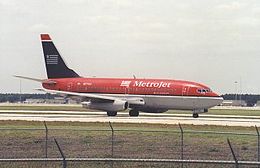- MetroJet Flight 2710
-
MetroJet Flight 2710 
A MetroJet 737-200, similar to the one involvedOccurrence summary Date February 23, 1999 Type Uncommanded rudder movement Site Salisbury, Maryland Passengers 112 Crew 5 Injuries 0 Fatalities 0 Survivors 117 (all) Aircraft type Boeing 737-2B7 Operator MetroJet (a subsidiary of US Airways) Tail number N282AU Flight origin Orlando International Airport Destination Bradley International Airport MetroJet Flight 2710 was a regularly scheduled flight from Orlando International Airport in Orlando, Florida to Bradley International Airport near Hartford, Connecticut. On February 23, 1999 the flight experienced uncommanded rudder movement and rolled to the right while flying over Maryland at 33,000 feet. The flight crew successfully landed the aircraft at Baltimore-Washington International Thurgood Marshall Airport in Maryland.[1] This incident is similar to other Boeing 737 rudder incidents, but in this case the rudder moved slowly to its blowdown limit in contrast to the sudden hardovers experienced by United Airlines Flight 585 and USAir Flight 427.
Contents
Incident
At approximately 11:15 a.m., while flying over Salisbury, Maryland, the Boeing 737-2B7 experienced an unintended wheel deflection while on autopilot and cruising at about 260 knots.[2] The pilots noticed the control wheel turn to the left, and quickly realized that the autopilot was turning the wheel to counteract rudder movement despite the rudder pedals having not been touched. The first officer discovered that the pedals were displaced to the right, so he disengaged the autopilot and pushed the left pedal to return the rudder to the center position. The pedals did not respond and seemed to be jammed. The pilots immediately followed an emergency procedure that had been created after the crash of USAir Flight 427. They disengaged the yaw damper and activated a standby rudder system that utilizes a backup hydraulic valve; the rudder pedals then moved back to center. After declaring an emergency and informing the passengers of the flight control problem, the pilots diverted the aircraft to Baltimore and landed without incident at 11:30 a.m.[3]
Investigation
Preliminary results of kinematic analysis and computer simulations using data from the flight data recorder indicated that the rudder moved slowly to its blowdown limit. Examinations of the rudder system did not reveal evidence of a servo valve failure or jam or any other malfunction that would explain the sudden rudder hardover. [1] A final report on what caused the incident has not been released.
See also
References
- ^ "Safety Of 737s In Question: Jet Unexpectedly Shifted During Tuesday Flight". CBS News. February 24, 1999. http://www.cbsnews.com/stories/1999/02/24/national/main36433.shtml.
- ^ "MetroJet B-737 in-flight event". NTSB. February 24, 1999. http://www.ntsb.gov/Pressrel/1999/990223.htm.
- ^ Adair, Bill. The Mystery of Flight 427: Inside a Crash Investigation. Washington: Smithsonian Institution Press, 2002.
External links
Aug 10 Atlantique incident
Aug 22 China Airlines Flight 642
Aug 31 LAPA Flight 3142
Sep 14 Britannia Airways Flight 226A
Sep 23 Qantas Flight 1
Oct 11 Air Botswana incident
Oct 25 South Dakota Learjet crashOct 31 EgyptAir Flight 990
Dec 07 Asian Spirit Flight 100
Dec 21 Cubana de Aviación Flight 1216
Dec 22 Korean Air Cargo Flight 8509
Dec 24 Indian Airlines Flight 814
Dec 25 Cubana de Aviación Flight 310Incidents resulting in at least 50 deaths shown in italics. Deadliest incident shown in bold smallcaps.Categories:- Aviation accidents and incidents in 1999
- 1999 in the United States
- Accidents and incidents on commercial airliners in the United States
Wikimedia Foundation. 2010.
